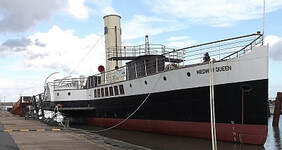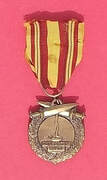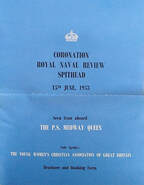This page illustrates the history of PS Medway Queen through images of unusual items from that history. It is not a comprehensive history of the ship, which is documented elsewhere on this site. "Odd Stuff" originated with Heritage Open Days 2020 comprising a blog under this same name and a "Curious Items" post on the HOD website.
Some of these items are on display at Gillingham Pier, others are from the PSPS Collection or MQPS members' private collections.
Some of these items are on display at Gillingham Pier, others are from the PSPS Collection or MQPS members' private collections.
Pre-war excursion service.
|
Medway Queen’s maiden voyage from Strood to Southend took place on Friday 18th July 1924 with a party of invited guests. From then until the outbreak of war she plied her trade on the Thames Estuary as indicated on this 1938 promotional leaflet for excursions from Southend. The ship was originally coal burning and early photographs show evidence of that in the funnel emissions. In 1938 she was reboilered and converted to oil firing which resulted in less visible smoke. A side effect of the fuel change was increased speed and convenience of refuelling which contributed to her ability to make so many trips during the Dunkirk evacuation. Medway Queen’s last pre-war voyages were assisting in the evacuation of vulnerable women and children from London to East Anglia in early September 1939.
|
|
The Chocolate Boy.
What a Job Description! The Chocolate Boy was obviously a summer season job and the chances are that the individual changed every year. His job was to prowl the decks making sure that everyone had a plentiful supply of chocolate and ice cream at a price that would sound cheap to us now but may not have been quite such a bargain at that time. Mr. Hayden Parker wrote in some years ago enquiring about his Grandfather who was the Chocolate Boy in 1935. The photo dates from a few years later. |
Wartime - Dunkirk.
|
Medway Queen and her crew made seven trips to Dunkirk in eight consecutive nights. The danger and sheer exhaustion must have taken an enormous toll and some, of course, did not manage all seven trips. Medway Queen is a small ship with a small crew but no less than seven of her men were rewarded for their gallantry. The certificate shown is for Thomas Irvine’s (2nd Engineer) MID which has been generously donated to the society. Thomas joined HMS Medway Queen in November 1939 and served on board throughout the war, including her time as a training ship.
WWII binoculars: a souvenir of Dunkirk. These binoculars were given to crewman Jack Skinner by a French officer when he was rescued from Dunkirk by HMS Medway Queen.
Jack kept a diary, which also featured in the Odd Stuff" blog and can be found by clicking the link below. |
|
The Dunkerque Medal was created in 1960 by the town of Dunkerque to commemorate the actions of May and June 1940. It was initially awarded to French personnel but in 1970 it was also awarded to any allied member involved in operation Dynamo. The example shown was awarded to Jim Chivers (RASC) who kindly left the medal to the Medway Queen Preservation Society in his will.
|

Lieutenant J. D. Graves was First Lieutenant of HMS Medway Queen at Dunkirk. His dress sword is on loan to the society and is shown left.
Post war excursions and Spithead Review.
|
Medway Queen returned to excursion service in 1947. A highlight of her post-war career was participation in the Coronation Naval Review at Spithead in 1953. The ship was included in the fleet for the formal review and also carried some 400 passengers who had travelled down from London Waterloo on a pre-booked excursion for the Young Women's Christian Association and their families.
The ticket price included a packed lunch and this rare item is the cardboard cover from a lunch box. It only survived because there is a laundry list written on the reverse! The lunches were fairly basic and not universally approved of by all accounts. The party left London (Waterloo) at 7am, travelled to Southampton where they boarded Medway Queen at one of the ocean liner docks. The tide was fairly low and disembarking train passengers’ first glimpse of their ship was the top of the funnel peering over the dockside! |
The Medway Queen Club. In 1966 Medway Queen opened as a static clubhouse and restaurant at a marina on the Isle of Wight.
|
Club Charm. A souvenir from Medway Queen’s time on the Isle of Wight. These sterling silver bracelet charms were one of the branded souvenir items sold on board. This one was a lucky find on an online auction site.
Matchbox. A souvenir from the 1970s depicting the "Medway Queen Club" on one side and the "Ryde Queen Boatel" on the other. Medway Queen served as a club/restaurant/disco on the Isle of Wight from 1966 to 1974. Cake Knife. Wedding receptions were a significant side-line and a souvenir cake knife was presented to each couple. This one was donated to the MQPS in 2016, the 50th anniversary year of the opening of the Medway Queen Club. |
Rescue preservation and rebuild.
|
Medway Queen was returned to the river Medway in 1984 for preservation. Our society was formed a year later to support that project but in due course was forced to buy the ship from the Official Receiver to save her from scrapping. It took many years of hard work but in 2009 a full rebuild was commenced in Bristol, largely funded by what was then the Heritage Lottery Fund (now National Lottery Heritage Fund).
Souvenir Bowl. Over the years we have used every possible route in fund raising. Before the Bristol rebuild when the old mast was found to be unusable in the rebuilt ship it was transformed into souvenir bowls to be sold in aid of the restoration. This bolt was removed from a paddle wheel during reconstruction but we have no way of knowing if it is an original from 1924 or, more likely, from one of many subsequent refits. The paddle wheels received attention in a 1942 refit in Granton (Edinburgh). Alfred Turnbull, who worked on that programme, recalled that they used punts moored alongside to get at the areas they were working on; parts were removed and lifted onto the quay. In the case of the “banjo” (the eccentric wheel hub that actuates the paddle feathering) this meant lowering it into the punt and then moving to the quayside. Unfortunately the heavy banjo slipped and both it and Albert plunged into the harbour. Albert was summoned to the foreman’s office where he explained that it wasn’t “lost” because he knew where it was. It was on the harbour bottom just near HMS Medway Queen!” Pub Sign. The restored "Medway Queen" pub sign which is now on show at the Visitor Centre: The sign was donated for display at the visitor centre when the pub closed and one side has been carefully restored by Peter Outen. The reverse side remains in its as received condition. |





















